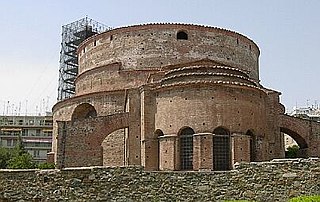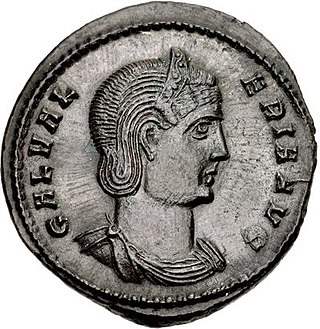Related Research Articles

Diocletian, nicknamed Jovius, was Roman emperor from 284 until his abdication in 305. He was born Diocles to a family of low status in the Roman province of Dalmatia. Diocles rose through the ranks of the military early in his career, eventually becoming a cavalry commander for the army of Emperor Carus. After the deaths of Carus and his son Numerian on a campaign in Persia, Diocles was proclaimed emperor by the troops, taking the name Diocletianus. The title was also claimed by Carus's surviving son, Carinus, but Diocletian defeated him in the Battle of the Margus.

The Tetrarchy was the system instituted by Roman emperor Diocletian in 293 AD to govern the ancient Roman Empire by dividing it between two emperors, the augusti, and their junior colleagues and designated successors, the caesares.
The 310s decade ran from January 1, 310, to December 31, 319.

Cyprian was a bishop of Carthage and an early Christian writer of Berber descent, many of whose Latin works are extant. He is recognized as a saint in the Western and Eastern churches.

Magnus Maximus was Roman emperor in the West from 383 to 388. He usurped the throne from emperor Gratian.

Flavius Valerius Constantius, also called Constantius I, was a Roman emperor from 305 to 306. He was one of the four original members of the Tetrarchy established by Diocletian, first serving as caesar from 293 to 305 and then ruling as augustus until his death. Constantius was also father of Constantine the Great, the first Christian emperor of Rome. The nickname "Chlorus" was first popularized by Byzantine-era historians and not used during the emperor's lifetime.

Galerius Valerius Maximianus was Roman emperor from 305 to 311. While acting as Caesar under Emperor Diocletian, Galerius obtained victory warring against the Sassanian Empire, defeating Narseh at the battle of Satala in 298 and possibly sacking the Sassanian capital of Ctesiphon in 299. He also campaigned across the Danube against the Carpi, defeating them in 297 and 300. Although he was a staunch opponent of Christianity, Galerius ended the Diocletianic Persecution when he issued the Edict of Toleration in Serdica (Sofia) in 311.

Galerius Valerius Maximinus Daza, born as Daza, was Roman emperor from 310 to 313. He became embroiled in the civil wars of the Tetrarchy between rival claimants for control of the empire, in which he was defeated by Licinius. A committed pagan, he engaged in one of the last persecutions of Christians, before issuing an edict of tolerance granting Christians their freedoms back near his death. Maximinus Daza is the last to be referred as Pharaoh of Egypt.

Flavius Valerius Severus, also called Severus II, was a Roman emperor from 306 to 307, and a member of the Tetrarchy. He shared control of the western half of the empire with Constantine I, but spent most of his short reign in a civil war against the usurper Maxentius, who later killed him and took over Italy.

The Edict of Milan was the February, AD 313 agreement to treat Christians benevolently within the Roman Empire. Western Roman Emperor Constantine I and Emperor Licinius, who controlled the Balkans, met in Mediolanum and, among other things, agreed to change policies towards Christians following the edict of toleration issued by Emperor Galerius two years earlier in Serdica. The Edict of Milan gave Christianity legal status and a reprieve from persecution but did not make it the state church of the Roman Empire, which occurred in AD 380 with the Edict of Thessalonica, when Nicene Christianity received normative status.

The Arch of Galerius or Kamara (Καμάρα) and the Rotunda (Ροτόντα) are neighbouring early 4th-century AD monuments in the city of Thessaloniki, in the region of Central Macedonia in northern Greece. As an outstanding example of early Byzantine art and architecture, in addition to the importance of the Rotunda as one of the earliest Christian monuments in the Eastern Roman Empire, both sites were inscribed on the UNESCO World Heritage List in 1988 as part of the Paleochristian and Byzantine monuments of Thessaloniki.

The Diocletianic or Great Persecution was the last and most severe persecution of Christians in the Roman Empire. In 303, the emperors Diocletian, Maximian, Galerius, and Constantius issued a series of edicts rescinding Christians' legal rights and demanding that they comply with traditional religious practices. Later edicts targeted the clergy and demanded universal sacrifice, ordering all inhabitants to sacrifice to the gods. The persecution varied in intensity across the empire—weakest in Gaul and Britain, where only the first edict was applied, and strongest in the Eastern provinces. Persecutory laws were nullified by different emperors at different times, but Constantine and Licinius' Edict of Milan in 313 has traditionally marked the end of the persecution.

Saint Catherine of Alexandria is an oil painting by the Italian Baroque master Caravaggio, painted from 1598-1599. It is part of the Thyssen-Bornemisza Collection of Madrid.

The Circus of Maxentius is an ancient structure in Rome, Italy, part of a complex of buildings erected by emperor Maxentius on the Via Appia between AD 306 and 312. It is situated between the second and third miles of the Via Appia, between the basilica and catacombs of San Sebastiano and the imposing late republican tomb of Caecilia Metella, which dominates the hill that rises immediately to the east of the complex. It is part of the Appian Way Regional Park.

Galeria Valeria was the daughter of Roman Emperor Diocletian and wife of his co-emperor Galerius.

Pannonia Superior was a Roman province created from the division of Pannonia in 103 AD, its capital in Carnuntum. It overlapped in territory with modern-day Hungary, Croatia, Austria, Slovakia, and Slovenia.
Saint Maximus of Jerusalem was an early Christian saint and bishop of Jerusalem from roughly 333 AD to his death in 347 AD. He was the third bishop of Jerusalem named Maximus, the other two being in the latter half of the 2nd century.
The Massa Candida were 153 or 300 early Christian martyrs from Utica who were martyred for their refusal to offering incense to Roman idols, around AD 258. They were put to death by Galerius Maximus, the governor of the province of Africa. The title "Massa Candida" or "White Mass or Lump" refers to their manner of death. The Catholic Encyclopedia reports that they were hurled into a pit of burning lime and thus reduced to a mass of white powder. They are commemorated on 24 August.

The German and Sarmatian campaigns of Constantine were fought by the Roman Emperor Constantine I against the neighbouring Germanic peoples, including the Franks, Alemanni and Goths, as well as the Sarmatian Iazyges, along the whole Roman northern defensive system to protect the empire's borders, between 306 and 336.
Candidianus was the son of the Roman Emperor Galerius and adoptive son of Galeria Valeria, the wife of Galerius and daughter of Diocletian.
References
- ↑ Acta proconsularia, iii.3; English translation in W.H.C. Frend, A New Eusebius: Documents illustrating the history of the Church to AD 337, revised edition (London: SPCK, 1987), pp. 247-250